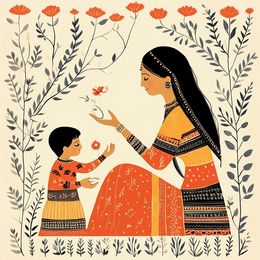In this digital age, where a tweet flutters away faster than a thought, the tradition of storytelling remains quintessential for our collective consciousness as well as our cultural connections. From the expansive realm of the Ramayan to the magnificence of the Mahabharat and the fantastical fables of the Panchatantra, India has a robust storytelling tradition that boasts a treasure trove of wisdom.
When I was a child, storytelling was a mandatory nightly ritual. My mother (former external affairs minister Sushma Swaraj) was usually the sutradhar [narrator], shouldering the responsibility of whisking me away to the land of the sandman with her vivid narrations. Her go-to aid would normally be the Panchatantra. Each narration would end with a moral of the story—a life lesson etched in my brain till date. On the days Ma was travelling, my father (former governor Swaraj Kaushal) took over with his own flair. He had just one story in his repertoire that was repeated unabashedly and designed to bore me to sleep. The plot was simple—it was about a boy and a stubborn radish stuck in the ground that the boy desired to pull out for a salad. Dad would spin a yarn naming every relative that came to help the boy in his arduous task. Just as I was about to drift off, he would drop the moral: “Ekta mein bal hai (There is strength in unity).” His plan of boredom as a path to slumber was surprisingly effective—who knew a radish could be so soporific?
The Indian heritage of storytelling is incredibly diverse. Yakshagana in Karnataka and Harikatha Kalakshepam in Tamil Nadu blend the art of storytelling with music and dance. Pandavani from Chhattisgarh dramatises the Mahabharat through dynamic performances by artistes like Teejan Bai. This style is a brilliant example of how mere recitation without theatrical spectacle can keep the audience invested in the narrative. In Rajasthan, Kaavad uses a portable wooden shrine with a beautiful panel of images painted on it. The Kaavadiya or the storyteller unveils these intricate panels while narrating the tales.
The proliferation of television channels in India and the omnipresence of social media, amplified by messaging platforms, have transformed storytelling traditions. Famous kathavachaks like Morari Bapu ji have used these platforms to widen their reach globally. In an age of influencers, millennial kathagayaks like Jaya Kishori ji or Gen Z kathavachaks like Indresh Upadhyay ji have mastered the spell of reels and captured a younger audience.
The Modi government has taken deliberate steps to preserve, propagate and promote India’s intangible cultural heritage and storytelling through initiatives like the ‘Scheme for Safeguarding the Intangible Cultural Heritage and Diverse Cultural Traditions of India’. The inclusion of 13 elements of intangible heritage in the UNESCO list highlights their global significance.
Digitisation has played a key role in the preservation of India’s storytelling. A digital repository of endangered tribal languages, rituals and stories has been created by the National Mission on Cultural Mapping. The Katputli Colony in Delhi used YouTube to share performances. Embracing technology is vital for preserving oral traditions. Digital archiving, interactive storytelling apps, social media campaigns and virtual sessions can enable these narratives to thrive.
Whether restricted by a 280-character limit or searching tirelessly for the right caption for your photo or creating a reel, we are all, on a daily basis, creating a story and setting a narrative. As rightly articulated by the Doctor played by actor Matt Smith in Doctor Who: “We are all stories in the end, just make it a good one, eh?”
Bansuri Swaraj is the Lok Sabha member from New Delhi.


